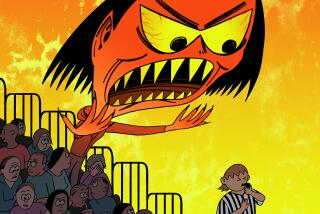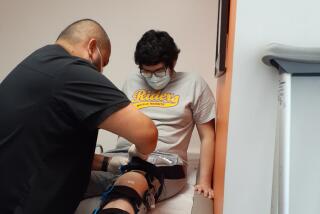Preparation Is Key to Minimizing Sports Injuries in Kids
- Share via
Each year, millions of children in the United States enjoy the benefits of participating in organized athletic programs. These children learn how to play cooperatively and how to be “good sports.” They improve their fitness level and, with any luck, they develop an enjoyment of sports that will be carried into adulthood.
However, a child’s participation in organized sports activities is not without certain risks. Every year, hundreds of thousands of these child athletes suffer injuries, ranging from mild to catastrophic. Medical experts agree that it is not possible to prevent every one of these injuries, but they have identified several preventive measures that significantly reduce the risk of a child being hurt.
These include medical examinations before beginning sports programs, preconditioning activities, the use of proper protective equipment, and adjustments for adverse weather conditions.
The first step is to have the child examined by a physician. In many states, such an exam is required before a child can participate in organized athletics. The purpose of this examination is to identify preexisting medical problems that could increase the risk of injury when the child is active. The exam is not designed to exclude children from participating (as some parents fear). In fact, there are very few medical conditions that would completely restrict a child from playing organized sports, and surveys show that only about 1% of athletes are denied clearance.
The medical checkup is also a good time to discuss with your child’s doctor proper training techniques and good nutrition. If a child is out of shape, a conditioning program should be started well before the scheduled sports activities. Poorly conditioned children are more likely to hurt themselves than those who are physically fit. Aerobic conditioning is important for almost any sport, but sport-specific training can also be useful. For example, a muscle-strengthening program that focuses on the shoulders and back can help prevent some injuries related to competitive swimming; stretching the muscles of the hips and legs can prevent some injuries associated with gymnastics and dancing.
Properly designed protective equipment can also prevent many sports-related injuries. Proper headgear and padding are especially important for children involved in contact sports such as football and martial arts, or high-velocity sports such as skiing, cycling and inline skating.
In hot weather, children are more likely than adults to become overheated and develop heat-related illness. To prevent problems, vigorous activity should be limited on very hot days to the early morning or late afternoon (preferably after sunset), when temperatures are cooler. Children should also be encouraged to consume lots of fluids. Plain cool water is a reasonable choice for activities lasting less than one hour; sports drinks (containing sugar and various electrolytes) are a better choice for activities that last longer.
A child ill with a fever or severe diarrhea is more susceptible to overheating and dehydration, and should avoid excessive physical activity, especially in the hottest weather. Although heat-related illness usually causes only mild symptoms, it can be life-threatening in severe cases. If there is any concern that a child may be developing a heat-related illness, a physician should be consulted.
Children who suffer a sports-related injury should not return to active play until the injury has completely healed. Trying to “play through” a supposedly minor injury can cause more extensive damage.
If there is any question about a child’s readiness for play, a doctor with expertise in treating sports injuries should be consulted.
(BEGIN TEXT OF INFOBOX / INFOGRAPHIC)
Protective Gear for Child Althletes
The American Academy of Pediatrics makes the following recommendations for protective gear for children’s sports activities:
* Baseball/softball: batting helmets, face and throat guards (catchers), sports goggles.
* Basketball: sports goggles.
* Cycling: bicycle helmets. * Fencing: full face cage.
* Field hockey: sports goggles, full face mask (goalie).
* Football: helmets, face masks, mouth guards.
* Ice hockey: full-cage helmet with chin strap, mouth guard.
* Lacrosse: head gear with face mask, mouth guard.
* Martial arts: head and chest protection.
* Racquetball: sports goggles.
* Inline skating: helmets, wrist guards.
* Skiing/snowboarding: helmets.
* Soccer: shinguards.
* Squash: sports goggles.
* Water polo: swim goggles.
* Wrestling: head gear with ear protectors.
*
Dr. Jonathan Fielding is the director of public health and the health officer for the Los Angeles County Department of Health Services. Valerie Ulene is a board-certified specialist in preventive medicine practicing in Los Angeles. They can be reached at [email protected]. Our Health runs the second and fourth Mondays of each month.
More to Read
Sign up for Essential California
The most important California stories and recommendations in your inbox every morning.
You may occasionally receive promotional content from the Los Angeles Times.










